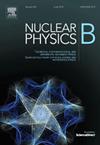Thermodynamic constraints and observational validation of the deceleration parameter
IF 2.8
3区 物理与天体物理
Q2 PHYSICS, PARTICLES & FIELDS
引用次数: 0
Abstract
In this work, we propose a two-parameter parametrization for the deceleration parameter grounded in thermodynamic constraints and applied it to explore the evolution of the universe. The second law of thermodynamics imposes essential conditions to ensure that the system approaches equilibrium in late times, requiring and as . These constraints ensure that entropy does not decrease, stabilize the system, and facilitate a smooth transition from deceleration to acceleration, consistent with the observed cosmic expansion. Furthermore, the model avoids the phantom regime (), preventing catastrophic future scenarios such as the Big Rip. Using the combined CC, Pantheon, SH0ES, and BAO datasets, we constrain the model parameters and compare the results with the standard ΛCDM model. Our findings indicate , with a transition redshift of , suggesting an earlier onset of acceleration compared to ΛCDM. The present deceleration parameter, , implies a weaker acceleration than in ΛCDM. Moreover, we analyze the evolution of total energy density, pressure, and the effective equation of state parameter, confirming a quintessence-like behavior with . Our results provide a thermodynamically consistent framework for cosmic expansion, supporting a dark-energy-driven acceleration.
减速参数的热力学约束和观测验证
在这项工作中,我们提出了一个基于热力学约束的减速参数q(z)的双参数参数化,并将其应用于探索宇宙的演化。热力学第二定律规定了确保系统在后期接近平衡的必要条件,要求q(z)≥−1,dqdz>;0为z→−1。这些约束确保了熵不会减少,稳定了系统,并促进了从减速到加速的平稳过渡,与观测到的宇宙膨胀一致。此外,该模型避免了幽灵状态(ω<−1),防止了灾难性的未来情景,如大撕裂。使用CC、Pantheon、SH0ES和BAO组合数据集,我们约束模型参数,并将结果与标准ΛCDM模型进行比较。我们的研究结果表明,H0=70.82±0.88,过渡红移zt=0.597±0.214,表明与ΛCDM相比,加速发生的时间更早。目前的减速参数q0=−0.364±0.032,意味着比ΛCDM中的加速度更弱。此外,我们分析了总能量密度、压力和状态参数的有效方程的演化,确定了ω0=−0.570±0.056的类精粹行为。我们的结果为宇宙膨胀提供了热力学上一致的框架,支持暗能量驱动的加速。
本文章由计算机程序翻译,如有差异,请以英文原文为准。
求助全文
约1分钟内获得全文
求助全文
来源期刊

Nuclear Physics B
物理-物理:粒子与场物理
CiteScore
5.50
自引率
7.10%
发文量
302
审稿时长
1 months
期刊介绍:
Nuclear Physics B focuses on the domain of high energy physics, quantum field theory, statistical systems, and mathematical physics, and includes four main sections: high energy physics - phenomenology, high energy physics - theory, high energy physics - experiment, and quantum field theory, statistical systems, and mathematical physics. The emphasis is on original research papers (Frontiers Articles or Full Length Articles), but Review Articles are also welcome.
 求助内容:
求助内容: 应助结果提醒方式:
应助结果提醒方式:


